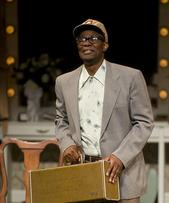SITE GUIDE
SEARCH
REVIEWS
REVIEW ARCHIVES
ADVERTISING AT CURTAINUP
FEATURES
NEWS
Etcetera and
Short Term Listings
LISTINGS
Broadway
Off-Broadway
NYC Restaurants
BOOKS and CDs
OTHER PLACES
Berkshires
London
California
New Jersey
DC
Philadelphia
Elsewhere
QUOTES
TKTS
PLAYWRIGHTS' ALBUMS
LETTERS TO EDITOR
FILM
LINKS
MISCELLANEOUS
Free Updates
Masthead
A CurtainUp Berkshire Review
Satchmo at the Waldorf
By Elyse Sommer
|
"He was a major-key artist whose lavish generosity of spirit was part and parcel of his prodigal way of making music."— Terry Teachout about Louis Armstrong in Pops, the biography that has morphed into the drama critic-author's first play. "I love the folks and they love me and we all have us a good time. Main thing is to live for that audience. That what you there for—to please the people."— Louis "Satchmo" Armstrong as he ruminates on his life and career in Satchmo at the Waldorf. “You can't play nothing on trumpet that doesn't come from him," Miles Davis once said |

John Douglas Thompson as Louis Armstrong
(Photo credit: Kenneth Sprague) |
Though Armstrong is the pivotal character, Teachout has structured his script to make Satchmo's powerful manager, Joe Glaser, have his say in this revealing rumination on the iconic musician/showman's life and career. The dual monologues works as a means to avoid this genre's tendency to come off more like a reading than a full--bodied drama. As importantly, the device serves to vividly illustrate how these two closely connected men, with different but well-meshed talents thumbed their noses at those who viewed catering to ticket buying audiences is tantamount to artistic compromise or selling out. Glaser felt Armstrong's big, long-term audience appeal lay in his being an all-around entertainer. Though the horn and the music he made with it was Armstrong's true passion, he also loved making audiences happy and so willingly followed Glaser's advice which made him a pop entertainer as well known for his raspy singing and big smile as his his unique trumpet playing.
For John Douglas Thompson alternating between Armstrong and Glaser is a chance to add yet another memorable performance to his growing resume of star turns. Though he explained at Shakespeare & Company's post opening celebration that being the only cast member was a new experience that took some getting used to for him, Thompson proves himself to eminently capable of holding the stage even without having other actors with whom to interact. Though he looks nothing like Armstrong, and even less so like Glaser, who was white, he becomes both men and segues from one to the other with remarkable smoothness.
A word about my above reference to "this stage of the play's life." The third performance of Satchmo at the Waldorf's run at the Tina Packer Theater, was billed as "a special localized press opening." This means that critics (and audiences) should be aware that the show isn't "frozen" but will undergo changes until its truly "official" opening at director Gordon Edelstein's Connecticut home base, the Long Wharf Theatre later this year .
I wholeheartedly agree with this decision to allow this dramatized new look at Louis Armstrong's crowd pleasing persona to evolve and change before an audience. Thompson seems to already have found ways into his role enabling him to compensate for the absence of other cast members. Teachout, a seasoned theater critic but a novice playwright, has wisely been in Lenox to take advantage of Edelstein's expertise to fine tune his script.
And so, the August 24th performance I saw was already different from the one some of my neighbors saw two nights earlier: The 90 minute running time listed in the program was already trimmed by close to 15 minutes even though the playwright added a third character, another influential jazz musician Miles Davis. The African-American Davis was just one of the many musicians and critics — white and black — who condemned Armstrong for using his unique gifts as a jazz trumpeter and compelling scat singer into a mass market entertainer best known for his "jillion times" performed super hit, “Hello Dolly."
Despite his disdain for what he viewed as Armstrong's pandering to white audiences, Davis once said "you can't play nothing on trumpet that doesn't come from him." Adding him as a character underscores the complexity of the art versus commerce conundrum and helps to lessen the tendency for this, like so many solo pieces, to rely more on plot devices than plot to move the story telling forward. As of now, however, the add-on segments still feel tossed in rather than fully thought through. Though director Edelsstein has staged the Davis snippets for Thompson to seamlessly switch characters, these brief segments seem to call for the addition of one or two other characters to make mini appearances (Dizzie Gillespie, another black musician and Armstrong critic and Jack Teagarden, the white blues man who played in Armstrong's band before forming his own band, come to mind), as well as a clearer reading from Thompson.
Given that this is being reviewed as a work-in-progress, there are a couple of items I would add to my wish list of changes between now and the final freeze. Mr. Teachout has a wonderful ear for authentic vernacular and Thompson for interpreting the dialogue, and at one point even singing a teensy riff of "Hello Dolly." However, I wish he'd ease up on his use of "motherfucker." I understand how that word quickly strips Armstrong of that crowd-pleasing niceness to reveal a somewhat tougher, rougher man However, Glaser's dialogue is peppered with plenty of expletives, so why not get rid of some the MFs.
I'd also like to see the playwright revisit his opening. Having Armstrong rush into his dressing room, exhausted and grabbing hold of the oxygen mask he apparently travels with, nicely establishes that this is a man in declining health. The words he speaks after he's able to breathe normally again would set the scene just as potently without adding his embarrassed revelation that he lost control of his bowels before the show. While that inelegant opening does have some shock value, it somehow seems unnecessary.
One thing I wouldn't change is Lee Savage's set with its backwall of a tripple dressing room mirror that with the expert help of Matthew Adelson's lighting, changes to a window looking out on the scene outside the Waldorf. It's a set that will work on a proscenium stage as well, if not even better, than the Tina Packer Theater's thrust stage.
Whatever version of Satchmo at the Waldorf you see, it's guaranteed to send you rushing to your CD and Ipod collection or to watch the many video clips of Louis Armstrong , both the jazz great, the ever smiling pop entertainer.
|
Satchmo at the Waldorf by Terry Teachout Directed by Gordon Edelstein Cast: John Douglas Thompson Costumes: Ilona Somogyi Set design: Lee Savage Lighting: Matthew Adelson SSound: John Gromada Stage Managers: Diane Healy & Hope Rose Kelly Running Time: Approximately 75 minutes without intermission Tina Packer Playhouse , Shakespeare & Company in Lenox FromAugust 22nd to September 16th Reviewed by Elyse Sommer at 8/24 press opening |
|
REVIEW FEEDBACK Highlight one of the responses below and click "copy" or"CTRL+C"
Paste the highlighted text into the subject line (CTRL+ V): Feel free to add detailed comments in the body of the email. . .also the names and emails of any friends to whom you'd like us to forward a copy of this review. Visit Curtainup's Blog Annex For a feed to reviews and features as they are posted add http://curtainupnewlinks.blogspot.com to your reader Curtainup at Facebook . . . Curtainup at Twitter Subscribe to our FREE email updates: E-mail: esommer@curtainup.comesommer@curtainup.com put SUBSCRIBE CURTAINUP EMAIL UPDATE in the subject line and your full name and email address in the body of the message. If you can spare a minute, tell us how you came to CurtainUp and from what part of the country. |


 Book of Mormon -CD
Book of Mormon -CD